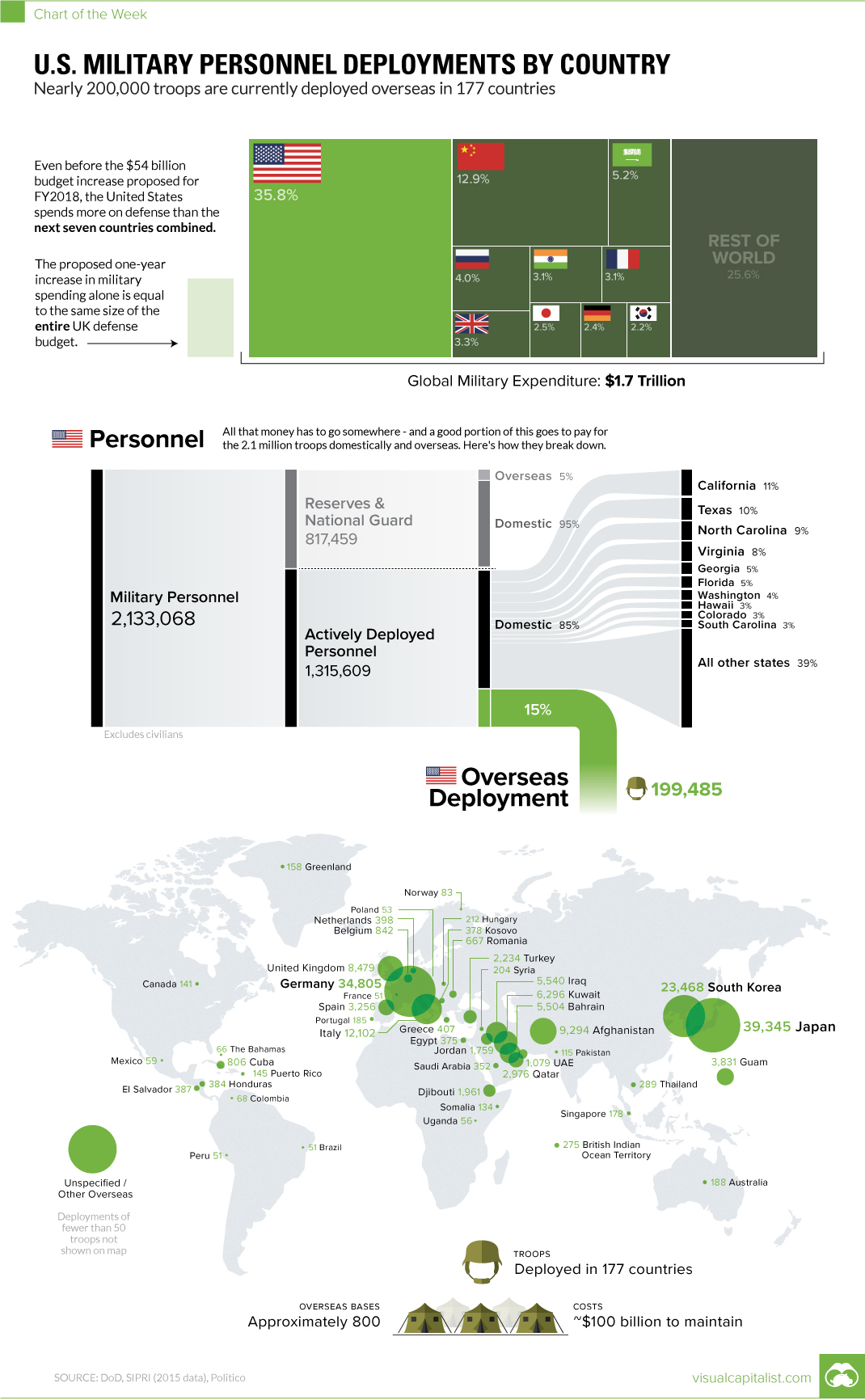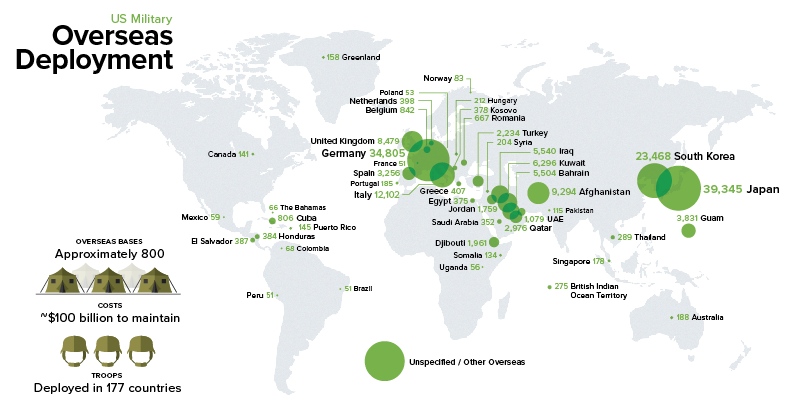Politics
U.S. Military Personnel Deployments by Country

U.S. Military Personnel Deployments by Country
200k active troops overseas in 177 countries
The Chart of the Week is a weekly Visual Capitalist feature on Fridays.
There was no shortage of cuts proposed in Trump’s budget for 2018, which was released earlier this week.
However, one of the few departments that did not receive a haircut was the Department of Defense. If the proposed budget ultimately passes in Congress, the DoD would be allocated an extra $54 billion in federal funding – a 10% increase that would be one of the largest one-year defense budget increases in American History.
To put the proposed increase in context, the United States already spends more on defense than the next seven countries combined. Meanwhile, the additional $54 billion is about the size of the United Kingdom’s entire defense budget.
| Country | Military Spending (2015) | Share |
|---|---|---|
| United States | $596 billion | 35.8% |
| China | $215 billion | 12.9% |
| Saudi Arabia | $87 billion | 5.2% |
| Russia | $66 billion | 4.0% |
| United Kingdom | $55 billion | 3.3% |
| India | $51 billion | 3.1% |
| France | $51 billion | 3.1% |
| Japan | $41 billion | 2.5% |
| Germany | $39 billion | 2.4% |
| South Korea | $36 billion | 2.2% |
| Others | $427 billion | 25.6% |
“Be All You Can Be”
With over half of all U.S. discretionary spending being put towards the military each year, the U.S. is able to have extensive operations both at home and abroad. Our chart for this week breaks down military personnel based on the latest numbers released by the DoD on February 27, 2017.
In total, excluding civilian support staff, there are about 2.1 million troops. Of those, 1.3 million are on active duty, while about 800,000 are in reserve or part of the National Guard.
On a domestic basis, there are about 1.1 million active troops stationed in the United States, and here’s how they are grouped based on branch of service:
| Military Branch | Active Domestic Personnel | As a Percentage |
|---|---|---|
| Army | 394,236 | 35% |
| Navy | 283,499 | 25% |
| Marine Corps | 149,992 | 13% |
| Air Force | 249,738 | 22% |
| Coast Guard | 38,659 | 3% |
| Total | 1,116,124 | 100% |
Internationally, there are just under 200,000 troops that are stationed in 177 countries throughout the world.
Here are the top 20 countries they are stationed in, as well as an “Other” category that represents the rest:
| Rank | Country / Territory | U.S. Troops |
|---|---|---|
| #1 | Japan | 39,345 |
| #2 | Germany | 34,805 |
| #3 | South Korea | 23,468 |
| #4 | Italy | 12,102 |
| #5 | Afghanistan | 9,294 |
| #6 | United Kingdom | 8,479 |
| #7 | Kuwait | 6,296 |
| #8 | Iraq | 5,540 |
| #9 | Bahrain | 5,504 |
| #10 | Guam | 3,831 |
| #11 | Spain | 3,256 |
| #12 | Qatar | 2,976 |
| #13 | Turkey | 2,234 |
| #14 | Djibouti | 1,961 |
| #15 | Jordan | 1,759 |
| #16 | United Arab Emirates | 1,079 |
| #17 | Belgium | 842 |
| #18 | Cuba | 806 |
| #19 | Romania | 667 |
| #20 | Greece | 407 |
| Other / Unknown | 34,834 | |
| Total | 199,485 |
In 2015, Politico estimated that there are 800 U.S. bases abroad, and that it costs up to $100 billion annually to maintain this international presence.
United States
Charted: What Southeast Asia Thinks About China & the U.S.
A significant share of respondents from an ASEAN-focused survey are not happy about rising American and Chinese influence in the region.

What Southeast Asia Thinks About China & the U.S.
This was originally posted on our Voronoi app. Download the app for free on iOS or Android and discover incredible data-driven charts from a variety of trusted sources.
This chart visualizes the results of a 2024 survey conducted by the ASEAN Studies Centre at the ISEAS-Yusof Ishak Institute. Nearly 2,000 respondents were asked if they were worried or welcoming of rising Chinese and American geopolitical influence in their country.
The countries surveyed all belong to the Association of Southeast Asian Nations (ASEAN), a political and economic union of 10 states in Southeast Asia.
Feelings Towards China
On average, a significant share of respondents from all 10 countries are worried about rising influence from both the U.S. and China.
However, overall skepticism is higher for China, at 74% (versus 59% for U.S.).
| Country | Worried About Growing 🇨🇳 Influence | Welcome Growing 🇨🇳 Influence |
|---|---|---|
| 🇧🇳 Brunei | 58% | 42% |
| 🇰🇭 Cambodia | 66% | 34% |
| 🇮🇩 Indonesia | 57% | 43% |
| 🇱🇦 Laos | 68% | 32% |
| 🇲🇾 Malaysia | 56% | 44% |
| 🇲🇲 Myanmar | 95% | 5% |
| 🇵🇭 Philippines | 81% | 19% |
| 🇸🇬 Singapore | 74% | 26% |
| 🇹🇭 Thailand | 84% | 16% |
| 🇻🇳 Vietnam | 96% | 4% |
| Average | 74% | 27% |
The recently-cooled but still active territorial concerns over the South China Sea may play a significant role in these responses, especially in countries which are also claimants over the sea.
For example, in Vietnam over 95% of respondents said they were worried about China’s growing influence.
Feelings Towards America
Conversely, rising American influence is welcomed in two countries with competing claims in the South China Sea, the Philippines (69%) and Vietnam (55%).
| Country | Worried About Growing 🇺🇸 Influence | Welcome Growing 🇺🇸 Influence |
|---|---|---|
| 🇧🇳 Brunei | 73% | 27% |
| 🇰🇭 Cambodia | 58% | 42% |
| 🇮🇩 Indonesia | 73% | 27% |
| 🇱🇦 Laos | 79% | 21% |
| 🇲🇾 Malaysia | 68% | 32% |
| 🇲🇲 Myanmar | 45% | 55% |
| 🇵🇭 Philippines | 32% | 69% |
| 🇸🇬 Singapore | 37% | 63% |
| 🇹🇭 Thailand | 80% | 20% |
| 🇻🇳 Vietnam | 45% | 55% |
| Average | 59% | 41% |
Despite this, on a regional average, more respondents worry about growing American influence (59%) than they welcome it (41%).
Interestingly, it seems almost every ASEAN nation has a clear preference for one superpower over the other.
The only exception is Thailand, where those surveyed were not a fan of either option, with 84% worried about China, and 80% worried about the U.S.
-

 Markets7 days ago
Markets7 days agoThe Best U.S. Companies to Work for According to LinkedIn
-

 VC+2 weeks ago
VC+2 weeks agoVC+: Get Our Key Takeaways From the IMF’s World Economic Outlook
-

 Demographics2 weeks ago
Demographics2 weeks agoThe Countries That Have Become Sadder Since 2010
-

 Money2 weeks ago
Money2 weeks agoCharted: Who Has Savings in This Economy?
-

 Technology2 weeks ago
Technology2 weeks agoVisualizing AI Patents by Country
-

 Economy2 weeks ago
Economy2 weeks agoEconomic Growth Forecasts for G7 and BRICS Countries in 2024
-

 Wealth1 week ago
Wealth1 week agoCharted: Which City Has the Most Billionaires in 2024?
-

 Technology1 week ago
Technology1 week agoAll of the Grants Given by the U.S. CHIPS Act













